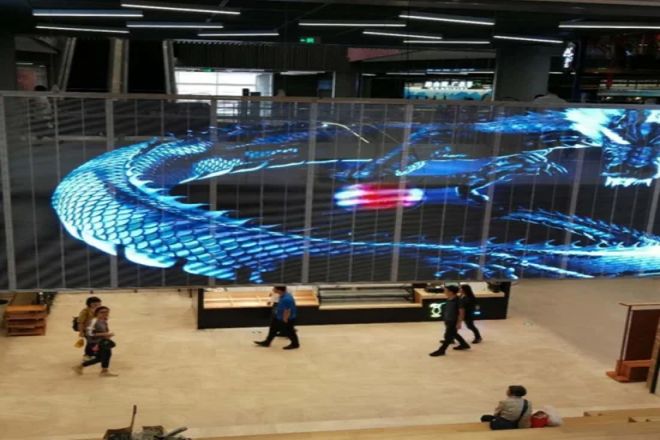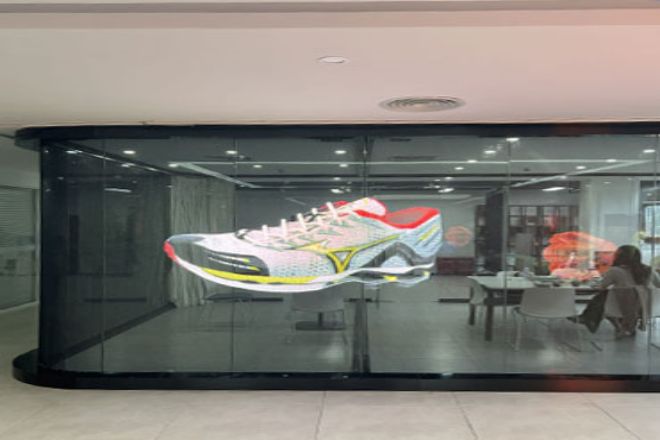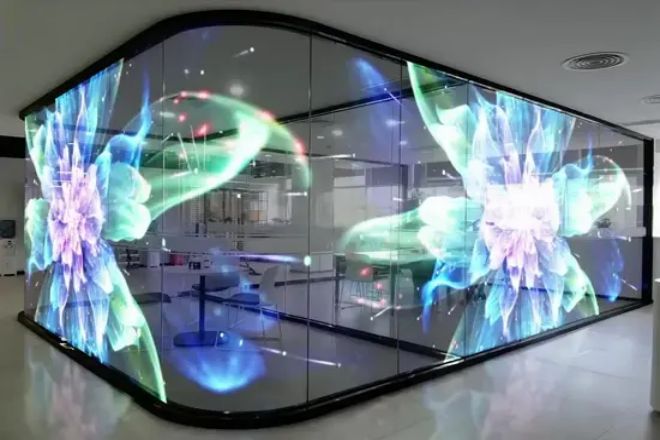소개

오늘날 기술이 급속히 발전하는 세상에서, 현실 세계와 가상 세계를 연결하는 다리 역할을 하는 디스플레이 기술은 전례 없는 속도로 발전하고 있습니다.
최초의 흑백 화면에서 컬러 LCD로, 그리고 오늘날의 OLED와 미니 LED와 같은 첨단 기술로, 각각의 도약은 우리의 시각적 경험을 크게 풍부하게 했습니다. 오늘날, 새로운 세대의 디스플레이 기술의 빛나는 진주로서, 3D 투명 LED 디스플레이 "디스플레이"라는 단어에 대한 우리의 이해를 조용히 바꾸고 있습니다.
이는 기존 디스플레이 화면의 2차원적 한계를 뛰어넘는 것뿐만 아니라, 독특한 투명성과 3차원적 감각으로 우리에게 새로운 시각적 시대를 열어줍니다.
무한한 가능성으로 가득한 이 시대에, 우리 함께 시각적 탐험 여행을 떠나보시죠. 단 2분 만에 3D 투명 LED 디스플레이 화면의 신비를 밝혀내고, 이 디스플레이가 선사하는 전례 없는 시각적 충격과 창의적인 영감을 느껴보세요.
1. 3D 투명 LED 디스플레이 화면 개요
이름에서 알 수 있듯이, 3D 투명 LED 디스플레이 화면은 LED 디스플레이 기술과 투명 소재의 혁신적인 디자인을 결합한 디스플레이 화면입니다.
높은 밝기, 높은 대비, 긴 수명, 밝은 색상과 같은 LED 디스플레이 화면의 전통적인 장점을 그대로 이어받았을 뿐만 아니라, 투명 기판 등 특수 소재를 사용하여 화면 자체의 투명성을 실현했습니다.
이 디자인을 통해 콘텐츠를 재생하는 동안 배경 풍경이나 빛이 자연스럽게 화면에 투과되어 전례 없는 시각적 계층과 공간감을 만들어내 "투명성"과 "3D" 효과의 진정한 결합을 달성했습니다.
구조적 특징:
- LED 램프 구슬:
디스플레이의 발광 유닛인 3D 투명 LED 디스플레이는 고밀도 마이크로 LED 램프 비드를 사용합니다. 이 램프 비드는 크기가 작고 밝기가 높을 뿐만 아니라 각 픽셀의 켜짐과 꺼짐을 정확하게 제어하여 섬세한 이미지 디스플레이를 구현할 수 있습니다.
동시에 투명성을 유지하기 위해 램프 비드의 레이아웃과 배열을 신중하게 설계하여 빛을 방출할 때 너무 많은 빛 침투를 차단하지 않도록 해야 합니다.
- 투명 기판:
투명 기판은 3D 투명 LED 디스플레이의 핵심 구성 요소 중 하나입니다. 일반적으로 유리 또는 높은 광 투과율을 가진 특수 플라스틱 소재로 만들어집니다.
이 기판은 우수한 기계적 특성과 안정성을 가질 뿐만 아니라, 더 중요한 것은 빛이 자유롭게 투과되도록 하여 화면 뒤의 풍경이나 빛을 선명하게 표현할 수 있다는 것입니다.
기판 소재와 구조를 최적화함으로써 화면의 투명성과 시각적 효과를 더욱 개선할 수 있습니다.
- 제어 회로:
제어 회로는 3D 투명 LED 디스플레이의 두뇌입니다. 외부 소스(예: 컴퓨터, 휴대전화 등)에서 신호를 수신하고 처리하고 이 정보를 LED 램프 비드가 켜지고 꺼지도록 하는 명령으로 변환하는 역할을 합니다.
고화질 및 매끄러운 디스플레이 효과를 달성하기 위해 제어 회로는 고속 데이터 처리 기능과 정밀한 픽셀 제어 기능을 가져야 합니다. 동시에 전반적인 투명성과 미학을 유지하기 위해 제어 회로는 일반적으로 얇은 디자인을 채택하고 투명한 기판 아래에 숨겨집니다.
2. 핵심기술 하이라이트

- 3D 디스플레이 효과
3D 투명 LED 디스플레이의 3D 디스플레이 효과는 가장 눈길을 끄는 핵심 기술 하이라이트 중 하나입니다. 이 효과를 달성하기 위해 디스플레이는 정교한 광학 설계와 고급 소프트웨어 알고리즘을 사용합니다.
광학적 설계 측면에서는 LED 램프 비드의 배열 밀도, 각도, 굴절, 반사 경로를 조정하여 3D 콘텐츠를 재생할 때 화면이 풍부한 3차원적 레이어링과 깊이감을 표현할 수 있습니다.
동시에 특수렌즈나 회절격자 기술과 결합하면 입체적인 시각효과를 더욱 강화해 관객이 마치 화면 속에 몰입한 듯한 느낌을 줄 수 있습니다.
소프트웨어 알고리즘 측면에서, 3D 투명 LED 디스플레이 스크린은 고급 이미지 처리 기술을 사용하여 원본 이미지를 심층적으로 분석하고 처리하고, 이미지 속의 3차원 정보를 추출하여 스크린 디스플레이에 적합한 형식으로 변환합니다.
알고리즘을 최적화함으로써 높은 선명도를 유지하면서 이미지가 더욱 사실적이고 자연스러운 3D 효과를 제공하도록 할 수 있습니다. 소프트웨어와 하드웨어의 이러한 조합은 3D 투명 LED 디스플레이 화면에 복잡한 장면과 동적 콘텐츠를 표시하는 데 고유한 이점을 제공합니다.
- 높은 투명도와 빛 투과율
높은 투명도와 광 투과율은 3D 투명 LED 디스플레이 스크린의 또 다른 핵심 기술적 하이라이트입니다. 이 목표를 달성하기 위해 디스플레이 스크린은 투명 기판 재료의 선택 및 처리에 많은 노력을 기울였습니다.
우선, 기판 소재는 빛이 화면을 매끄럽게 통과할 수 있도록 좋은 빛 투과율을 가져야 합니다. 시중에서 일반적으로 사용되는 투명 기판 소재로는 빛 투과율이 높은 유리, 특수 플라스틱 등이 있습니다.
이러한 재료는 높은 투과율뿐만 아니라 우수한 기계적 성질과 안정성을 가지고 있어 디스플레이 화면의 사용 요건을 충족시킬 수 있습니다.
둘째, 기판 소재의 가공 기술 측면에서도 투명성을 향상시키기 위해 다양한 방법을 활용하고 있습니다.
예를 들어, 표면 처리 공정을 최적화하면 기판 표면의 반사 및 산란을 줄여 빛의 투과율을 향상시킬 수 있습니다. 또는 다층 박막 중첩 기술을 사용하여 서로 다른 재료 간의 굴절률 차이를 활용하여 빛의 투과 효과를 향상시킬 수 있습니다.
이러한 기술적 수단을 적용하면 3D 투명 LED 디스플레이는 높은 투명성을 유지하는 동시에 뛰어난 시각적 효과와 색 재현성을 달성할 수 있습니다.
- 유연한 사용자 정의 및 설치
3D 투명 LED 디스플레이의 모듈식 설계는 유연한 사용자 정의 및 설치의 핵심입니다. 디스플레이는 여러 개의 독립 모듈로 구성되어 있으며, 각 모듈에는 특정 수의 LED 램프 비드와 제어 회로가 포함되어 있습니다.
이러한 설계를 통해 디스플레이를 실제 필요에 따라 유연하게 이어 붙이고 결합해 다양한 모양과 크기의 설치 환경에 적응할 수 있습니다.
게다가 모듈형 디자인은 많은 편의성을 제공합니다.
예를 들어, 설치 과정에서는 현장 여건에 맞게 모듈의 위치와 개수를 유연하게 조정해 최상의 시각적 효과와 설치 효과를 얻을 수 있습니다. 유지 관리 시 모듈에 고장이 나거나 손상된 경우, 전체 디스플레이의 정상적인 작동에 영향을 주지 않고 모듈을 분리해 교체할 수 있습니다.
이러한 유연성과 유지 보수 용이성 덕분에 3D 투명 LED 디스플레이는 대규모 상업용 디스플레이, 공공 예술 설치 및 기타 분야에서 폭넓은 적용 가능성을 가지고 있습니다.
3. 응용 시나리오 표시
- 상업 광고
상업 분야에서 3D 투명 LED 디스플레이 스크린은 점차 주요 쇼핑몰, 공항 및 기타 혼잡한 지역의 새로운 인기 품목이 되어 가고 있으며, 독특한 시각 효과와 강한 매력을 가지고 있습니다.
이러한 디스플레이 화면은 고화질 및 생생한 광고 콘텐츠를 재생할 수 있을 뿐만 아니라, 더 중요한 것은 디스플레이 화면 자체의 투명한 특성을 이용해 광고 정보를 화면 뒤의 환경이나 풍경과 통합하여 전례 없는 시각적 효과를 창출할 수 있다는 것입니다.
고객이 이러한 구역을 이동할 때 화면에 나오는 멋진 그림에 끌려 무의식적으로 멈춰서 시청하게 되며, 이는 광고의 커뮤니케이션 효과와 브랜드 이미지를 효과적으로 향상시킵니다.
또한 3D 투명 LED 디스플레이 화면은 동적 콘텐츠 업데이트와 원격 제어를 지원하여 광고주가 시장 수요와 축제 분위기에 따라 광고 콘텐츠를 유연하게 조정하고 광고를 항상 새롭고 시기적절하게 제공할 수 있습니다.
- 미술 전시회
문화예술 분야에서도 3D 투명 LED 디스플레이 스크린은 특별한 매력을 보여줍니다. 박물관, 미술관과 같은 전시장에서 이러한 디스플레이 스크린은 예술 작품 전시에 교묘하게 통합되어 전통과 현대, 현실과 가상을 연결하는 다리가 됩니다.
역동적인 이미지, 역사적 배경 또는 예술 작품과 관련된 창작 과정을 통해 관람객은 예술 작품을 감상하는 동안 보다 포괄적이고 심층적인 이해와 경험을 얻을 수 있습니다. 더 중요한 것은 3D 투명 LED 디스플레이의 상호 작용성이 예술 전시를 경험하는 새로운 방식을 제공한다는 것입니다.
관객은 터치 스크린, 제스처 인식 등의 방법을 통해 화면과 상호작용하고, 예술 작품 제작과 전시에 참여하며, 전례 없는 참여와 몰입을 즐길 수 있습니다.
- 스마트 홈
스마트 홈이라는 개념이 대중화되고 기술이 꾸준히 발전함에 따라, 3D 투명 LED 디스플레이도 가정 장식 및 스마트 유리창과 같은 분야에서 폭넓은 적용 가능성을 보여주기 시작했습니다.
홈 데코레이션 측면에서 이러한 디스플레이는 다양한 모양과 크기로 설계되어 실내 장식의 일부로 벽, 천장 또는 가구에 내장될 수 있습니다. 가족 구성원이 좋아하는 음악, 비디오 및 기타 콘텐츠를 재생할 수 있을 뿐만 아니라 주변 조명과 분위기에 따라 밝기와 색상을 자동으로 조정하여 따뜻하고 편안한 생활 환경을 조성할 수도 있습니다.
스마트 유리창의 경우, 3D 투명 LED 디스플레이는 지능형 제어 시스템과 결합하여 창문의 지능형 개폐, 차양, 단열 및 기타 기능을 실현할 수 있습니다. 동시에 날씨 예보, 시간 및 날짜, 가정 안전 정보와 같은 실용적인 정보를 표시하는 정보 디스플레이 플랫폼 역할도 하여 가정 생활에 편리함과 편안함을 가져다줍니다.
이러한 응용 분야는 생활의 질을 향상시킬 뿐만 아니라 미래 생활 공간의 일부로서 3D 투명 LED 디스플레이의 무한한 잠재력을 보여줍니다.
4. 기술적 장점과 과제

1). 기술적 장점
- 뛰어난 시각 효과:
3D 투명 LED 디스플레이는 정교한 광학 설계와 소프트웨어 알고리즘을 통해 3차원의 시각적 경험을 구현하여 시청자에게 보다 현실적이고 생생한 영상 효과를 경험할 수 있게 해줍니다.
이 독특한 디스플레이 효과는 시각적 충격을 강화하는 것뿐만 아니라 관객의 몰입감과 참여감을 높여 상업 광고, 미술 전시 및 기타 분야에 새로운 디스플레이 방식을 제공합니다.
- 에너지 절약 및 환경 보호:
기존 디스플레이와 비교해 3D 투명 LED 디스플레이는 에너지 소비 측면에서 상당한 이점을 가지고 있습니다.
고효율 LED 광원과 최적화된 회로 설계를 사용하여 이러한 디스플레이는 높은 밝기와 높은 선명도를 유지하면서도 에너지 소비를 크게 줄이고 환경에 미치는 영향을 줄일 수 있습니다.
또한, 투명한 특성 덕분에 콘텐츠를 표시할 필요가 없을 때도 화면이 빛을 통과시켜 에너지 소비를 더욱 줄일 수 있습니다.
- 편리한 설치:
3D 투명 LED 디스플레이의 모듈식 설계는 설치 프로세스를 보다 유연하고 편리하게 만듭니다. 사용자는 다양한 모양과 크기의 설치 환경에 적응하기 위해 실제 필요에 따라 스플라이싱 및 조합을 위한 다양한 수와 크기의 모듈을 선택할 수 있습니다.
동시에 이러한 설계는 이후의 유지관리 및 교체 작업에도 편리하여 유지관리 비용과 시간적 비용을 줄여줍니다.
2). 도전과제
- 기술 성숙도:
3D 투명 LED 디스플레이 화면은 시각적 효과와 기술적 성능 면에서 상당한 이점을 가지고 있지만, 기술 성숙도는 여전히 개선되어야 합니다.
현재 시장에는 고품질 3D 투명 LED 디스플레이 화면을 제공할 수 있는 회사가 비교적 적고 기술 표준과 사양이 아직 완전히 통일되지 않았습니다. 이로 인해 이 기술의 홍보 및 적용 범위가 어느 정도 제한되었습니다.
- 비용 관리:
3D 투명 LED 디스플레이 스크린은 고품질 소재와 첨단 기술 공정을 사용하기 때문에 비용이 비교적 높습니다. 이는 예산이 제한된 일부 사용자에게 큰 과제가 될 수 있습니다. 따라서 품질을 보장하면서 비용을 절감하는 것은 이 기술의 미래 개발을 위해 해결해야 할 중요한 문제 중 하나입니다.
- 콘텐츠 제작:
3D 투명 LED 디스플레이 스크린의 디스플레이 효과는 콘텐츠 제작에 더 높은 요구 사항을 제시합니다. 입체적 시각적 이점을 최대한 활용하려면 고품질, 고화질 3D 콘텐츠를 제작해야 합니다.
그러나 이러한 콘텐츠를 제공할 수 있는 전문 기관과 인재가 시장에는 상대적으로 적고 콘텐츠 제작 비용도 상대적으로 높습니다. 이로 인해 특정 분야에서 이 기술의 적용 및 개발이 어느 정도 제한되었습니다.
3) 향후 개발 동향 및 솔루션
기술의 끊임없는 진보와 시장의 끊임없는 발전에 따라 3D 투명 LED 디스플레이 스크린의 미래 개발 전망은 밝습니다.
위의 과제를 극복하고 보다 폭넓은 응용 및 개발을 이루기 위해 다음과 같은 측면부터 시작할 수 있습니다.
- 기술 연구개발 및 표준화 건설 강화:
R&D 투자와 기술 혁신을 확대하여 3D 투명 LED 디스플레이 기술의 지속적인 성숙과 개선을 촉진합니다. 동시에 업계 내 표준화 건설을 강화하고 통일된 기술 표준 및 규격을 제정하며 제품의 호환성과 상호 교환성을 개선합니다.
- 비용 구조 최적화:
대량 생산, 생산 공정 최적화, 소재 선택을 통해 생산 비용을 절감합니다.
동시에, 공급업체 및 파트너와의 협력과 협의를 강화하여, 보다 유리한 조달 가격과 보다 효율적인 공급망 관리를 위해 노력해야 합니다.
- 콘텐츠 제작 산업의 발전을 촉진합니다.
전문 기관과 인재가 3D 콘텐츠 제작의 개발과 혁신에 헌신하도록 격려하고 지원합니다. 정책 지원, 재정 지원 및 교육 지침을 제공하여 창의적 열정을 자극하고 창의적 수준을 향상시킵니다.
동시에 영화·TV, 게임, 광고 등 관련 산업과의 협력 및 교류를 강화하여, 3D콘텐츠 창작산업의 번영과 발전을 함께 촉진해야 한다.
결론
3D 투명 LED 디스플레이 기술의 지속적인 성숙과 대중화로 우리는 미래의 시각적 세계가 더욱 다채롭고 생생하며 흥미로울 것이라고 믿을 만한 이유가 있습니다. 그것은 기술 진보의 상징일 뿐만 아니라 인간의 창의성과 상상력의 결정체이기도 합니다. 빛과 그림자가 뒤섞인 이 꿈의 무대에서 모든 디테일은 지혜의 빛으로 빛나고 모든 혁신은 더 나은 미래를 예고합니다.
마지막으로 LED 디스플레이에 대해 더 알고 싶으시다면, 우리에게 연락해주세요.
